- Silicon Fashion Peak. Celeron 2400 @ 3600
The subject
We've got the unique opportunity to take a glance in the near future of CPU industry. We've got the latest (just yesterday released in Japan) engeneering sample of Celeron 2.4Ghz processor. 2 particular facts about this wonderful future product made this article not only a review of the upcoming (for all markets except japanese) processor.
First, like most processors labeled Intel confidential, our sample has an unlocked multiplier.
Second, this processor gone stock in Japan at 30.03.2003, and still cannot be found in other countries, that's why it's an EXCLUSIVE REVIEW!Testbed
System:
Motherboard ASUS P4B533-VT
Memory 256Mb Crucial PC2100 DDR
Video S/U/M/a/ Platinum GF4Ti4400
HDD 80Gb Seagate Barracuda 4
Sound Creative SBLive! 5.1
PSU 300W Chieftec
Furry case "Project Rufortina" :)
Processors:
Intel Pentium 4 2.0Ghz B-stepping, Intel Confidential.
Intel Celeron 2.4Ghz C1-stepping, Intel Confidential.
Cooling solution:
DIY liquid cooling system (800lph, copper waterblock, copper truck radiator)
Application performance had been tested with a bunch of synthetic benchmarks like SiSoft Sandra 2003 Professional (CPU Arithmetic Benchmark & CPU Multimedia Benchmark), 3DMark 2001 SE (default benchmark), and real-life professional application 3DSmax5. In 3DSmax5 benchmarks, we used the radiosity.max scene from default program complectation. The benchmark was based on Camera 8 viewport rendering in 1024x768 resolution, with Enable SSE turned on. The resulting render time was used as a bench result.Closeup
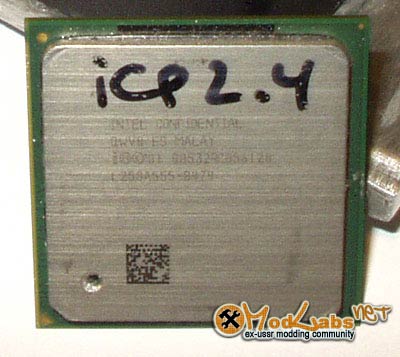
There is a special labeling for Intel confidential samples, absolutely different from the one for open market. There's no traditional 5-symbols sSpecs.
Our sample has been labeled as:
INTEL CONFIDENTIAL
QWV8 ES MALAY
80532RC056128
L250A555-0474
Intel Celeron 2.4 price in Japan is about $130. Official Intel's price is $127.Default frequency benchmarks
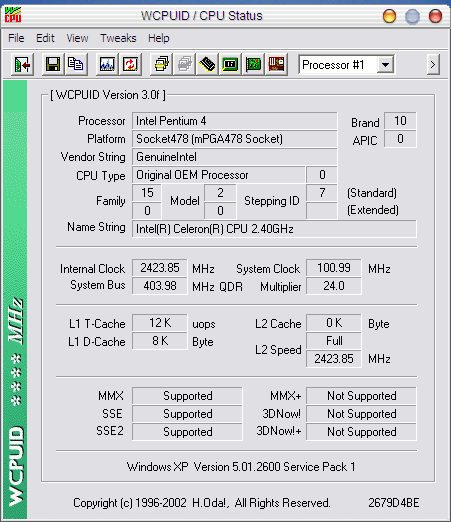
The real FSB/Multiplier ratio of this processor remains a secret even for us due to unlocked multiplier. We can suppose that like all Celeron processors this one works on 100 (400 QDR) Mhz FSB and and a corresponding multiplier of 24. However Sisoft Sandra reports strange 120/20x ratio. The standard core voltage is 1.525V. If you look through WCPUID screenshot more attentively, you'll find some strange things going on. WCPUID reports no on-die L2-cache installed, although Sandra found normal 128 kB. The problem is in processor's origin. Actually, even some motherboards cannot detect Confidential CPUs right - we've got Mobile Celeron 2.0 that was identified as "Intel Xeon" by some mobos.
Results on default frequency (2400Mhz)
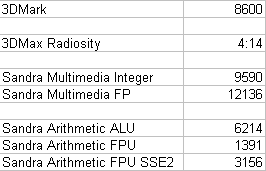
Not bad for lo-end product, except an awful result in 3DMark. Don't even try to build a gamestation around Celeron - you have to find something more powerful for your hardcore gaming needs.Overclocking: disclaimer
At least we're up to overclocking, and I have a small disclaimer you should read before going to the next store for your new Celeron.
I'd like to remind our readers that:
- The potential of engineering samples of CPUs is usually unpredictable and can be much higher or lower then of serial ones;
- The unlocked multiplier gives us much more overclocking abilities;
- First batches might overclock not as good as the later ones;
- Celeron processor has only 128kb of cache memory, so it can be overclocked much better then Pentium 4 of the same frequency.
Some serious speed
First, lets try to get the best this CPU can using the unlocked multiplier. Core voltage has been raised to 1.8V. On 2V system automatically turns off from PSU overload. We used a wiretrick method to give this CPU voltages more then 1.825 later. The rock stable frequency is 3600 Mhz, which is 1,5 times bigger then nominal. On this frequency we could run all tests except 3DSmax that required 1.85 for full stability.
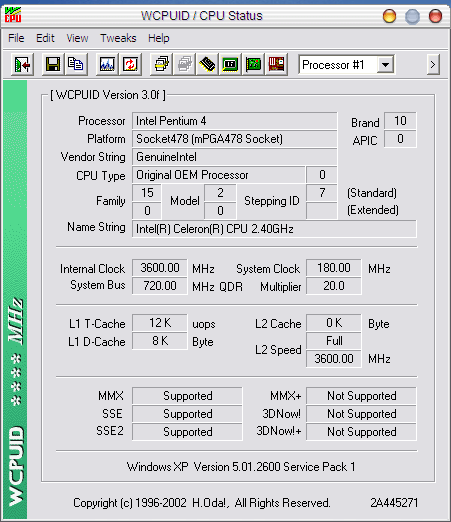
This reminds of legendary Celeron 300A, P3-450, Celeron 600 and the latest Celeron 2GHz that showed similar results. The multiplier was set to 20 and FSB equalled 180 (720 QDR). Memory worked in synchronous mode. Load temp was 42, Idle 38. Estimated Performance Rating, reported by Sandra, was 3965, and approximate power consumption - 141 W.
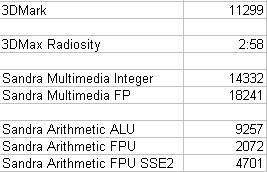
Maximum frequency that we could screenshot using WCPUID was 3660 Mhz (183x20). Though the stability on this frequency was very poor even on 1.95V. We could only run Sandra's CPU information, which informed us about estimated PR-rating (4025) and power consumption (151W).
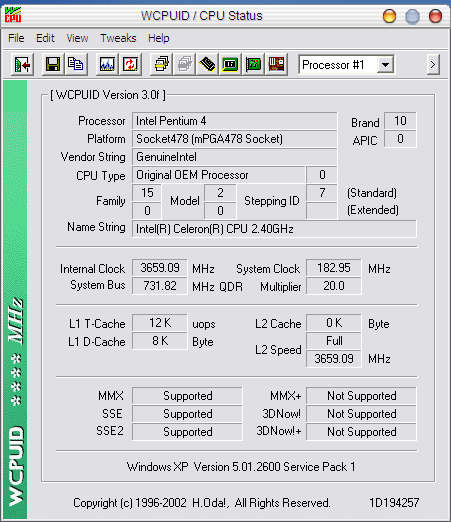
The maximum frequency on which PC went through POST was a bit more then 3800 Mhz. Of course Windows didn't load on this frequency.
Then, we tried to simulate the stock Celeron with fixed multiplier. Result was absolutely the same - maximum stable frequency is 3600 MHz as 150x24, so there is nothing to speak about.Comparison
We couldn't find Pentium 4 2.4 anywhere, that's why we have to compare new Celeron with P4 2.0. Just look through the charts - no comments needed imho.
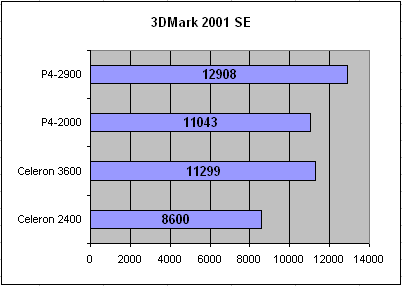
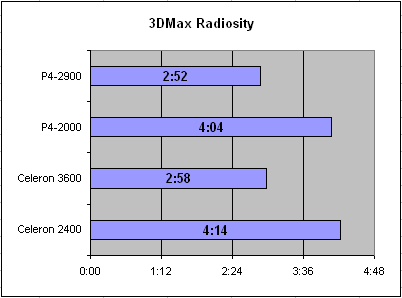

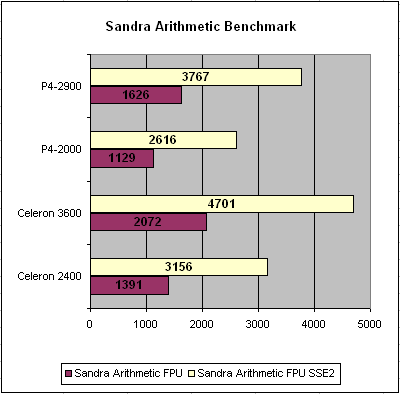
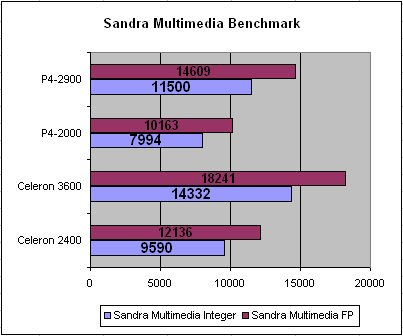
Conclusion
So, what can we say about the new Celeron 2400? By itself the processor is nothing unusual, as expected. The budget series of Intel processors raised their frequency on another 200 Mhz, with the corresponding performance boost. The thing that is more interesting to us now, is the overclocking results. No, Celeron 2400@3600 didn't become a miracle of ages, it has just won by raw MHz. Even being 700 Mhz ahead Pentium 4 it showed slightly lower performance in professional applications though won the battle of pure power in synthetic Sandra benches. As for 3DMark, Celeron suffered a bitter defeat. With all its outstanding potential, running at 3600Mhz and 720FSB Cel-2400 barely overstripped P4 at default frequency 2400/533. I cannot recommend using this processor for professional needs or for hardcore gaming machine, but its rather nice for a quite powerful, but still budget, home PC. Actually, don't forget that Intel is positioning Celerons for value market, that's why it was a bit unfair to compete Cel 2.4 with P4. For its price (we hope it'll be about $100-120 when it will reach Europe and US) new processor demonstrated impressive performance and awesome potential for overclocking. Anyway, this is your first chance to reach 3.5GHz without extreme methods and, moreover, on lo-end CPU.
Well, we have tested a pre-production sample and still don't have any information about other C2400 overclocking results. We have some doubts that stock CPUs will be able to achieve that marvellous result. But if other reviews will confirm our 3600MHz, then... Grab it quickly!!!© ALT-F13















